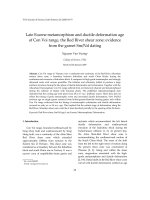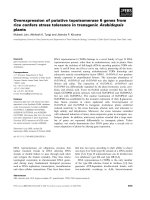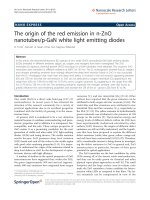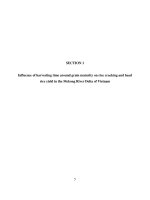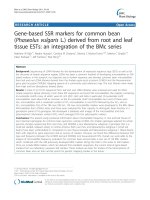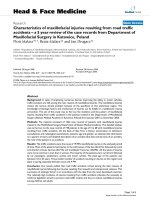NCKH BLACK CARBON EMISSION FROM RICE STRAW OPEN BURNING IN SOME PROVINCES OF THE RED RIVER DELTA
Bạn đang xem bản rút gọn của tài liệu. Xem và tải ngay bản đầy đủ của tài liệu tại đây (3.5 MB, 35 trang )
VIETNAM NATIONAL UNIVERSITY, HANOI
VNU UNIVERSITY OF SCIENCE
FACULTY OF ENVIRONMENTAL SCIENCE
BLACK CARBON EMISSION FROM
RICE STRAW OPEN BURNING
IN SOME PROVINCES OF THE RED RIVER DELTA
Supervisor: Assoc.Prof.Dr Hoang Xuan Co
Student: Vu Thi Hanh1
INTRODUCTION
•
•
•
•
Black Carbon (BC)
One of the Short-live Climate Forcer
The second most important contributor to global warming
Having negative impacts on climate, public health, agriculture and ecosystem
The RRD is the second most important rice-producing area in Vietnam; rice cultivation generates huge amounts of rice straw.
Burning rice straw in the field becomes a popular activity main source of BC aerosol and directly effect on local air quality.
Method to estimate or measure BC emission are neccesary
2
Contents:
Chapter 1: Overview
•
•
•
1.1. Black Carbon
1.2. Study area
1.3. Rice straw burning in the field
Chapter 2: Objects and Methodology
•
•
2.1. Objects to study
2.2. Methodology
Chapter 3: Results and Discussions
•
•
•
•
•
3.1. Summary data acquistion
3.2. Estimate Black Carbon emission
3.3. Compare the results of the two approaches
3.4. Measurement of Black Carbon
3.5. Solution to reduce rice straw open burning
3
Chapter 1
4
1.1. Black carbon
•
•
Production of incomplete combustion
Consisting of soot, charcoal, and possible light-absorbing
refractory organic matter
•
Having short atmospheric lifetime One of the short-lived
climate forcers
Source: US EPA
Transmission electron microscopy image of
a representative soot particle
5
1.1. Black Carbon
1.1.2. Sources of Black Carbon
•
Natural sources: include erupting volcanoes, wildfires
Erupting volcanoes
Wildfire
6
• Anthropogenic sources:
Biomass open burning
Residential cooking
Source: US EPA
Industrial process
Transportation
7
1.1. Black Carbon
1.1.3. Physical properties
• Strongly absorption of visible light
• Refractory
• Insoluble in water and organic solvents
• Aggregate of small carbon spherules
BC is very distinctive
Source: Bond et al, 2013
Black Carbon aggregates
8
1.1. Black Carbon
1.1.4. Impacts of BC
Climate impacts:
- Direct radiative forcing:
Change in the energy
balance due to absorption and scattering of sunlight
-Interactions with clouds:
+ Changing cloud distributions
+ Changing the number concentration of liquid cloud droplets
-Snow/ice albedo effect:
Reduced albedo Increases surface melting
-Other impacts:
Change in precipitation patterns Change surface dimming
Source: T.C Bond
BC direct radiative forcing
9
1.1. Black Carbon
Health public impacts
-
BC visibility associated with PM2.5
Result in millions of premature deaths worldwide, including:
+ Aggravation of respiratory
+ Cardiovascular disease
+ Impaired lung function
+ Changes in heart rhythm
- Reducing BC can prevent 640,000 to 4,900,000 premature deaths every year.
Agriculture and ecosystem impacts:
- Reduce agricultural production
- Affect ecosystems’ carbon uptake
- Affect metabolic processes of foliage
10
1.2. Study area
Red River Delta:
-
Location:
0
0
Latitude: 21 34’ to 19 5’ North
0
0
Longitude: 105 17’ to 107 7’ East
-
Topography: mainly flat (0.4 – 12m above sea level)
Including 11 provinves and cities
High population density
The second most important rice-producing area, accounting
15.2% of the national crop
11
Table: National condition and socio-economic situation by provinces
Natural condition
Socio-economic
Hanoi
Vinh Phuc
Ninh Binh
Topography
Plain, midland, mountainous
Plain, midland, mountainous
Plain, hill and mountain, the coastal area
Climate
Humid subtropical
Tropical monsoon
Trophic and monsoon
Hydrology
Red River, Da River, Duong River, Cau River...
Red River, Lo River,...
Day River, Hoang Long River, Boi River, Vac River,...
The economic structure
Region 1: 5.36%
Region 1: 10.69%
Region 1: 14.24%
Region 2: 41.56%
Region 2: 60.39%
Region 2: 42.91%
Region 3: 53.08%
Region 3: 28.92%
Region 3: 42.85%
Population
Total: 7,146.2
Total: 1,029.4
Total: 927
(thous.persons)
- Urban population: 3,089.2
- Urban population: 243.8
- Rural population 4,057
- Rural population: 785.6
-
- Total area planted with annual crops:
- Total area planted with annual crops: 96.05
- Total area planted with annual crops: 110.4 thous.ha
295,916.5 ha
thous.ha
- Aquacultural area: 10.2 thous.ha
- The area of planted forests: 237.1 ha
- The area of planted forests: 884 ha
- The area of planted forests: 20.85 thous.ha
situation
Agricultural production
Urban population: 177.3
Rural population: 749.7
- Aquaculture area: 6,926 ha
12
1.2. Study area
Table: Agricultural production situation of commune in province, 2013
Tho Xuan ( Hanoi)
Ngoc Thanh (Vinh Phuc)
Gia Xuan (Ninh Binh)
-
-
-
Rice production:
Rice production:
Rice production:
+ Total area: 130.4 ha
+ Total area: 1,030.5 ha
+ Total area: 303.6 ha
+ Production: 840.133 tons
+ Yeilds: 4.37 tons/ha
+ Production: 1,219.062 tons
-
-
-
Corn production:
Corn production:
+ Total area: 108.2 ha
+ Total area: 140.8 ha
+ Production: 594.056 tons
+ Yeilds: 6.94 tons/ha
-
-
Soybean production:
+ Total area: 13.5 ha
Sweet potatoes, cassava:
+ Total area: 152.7 ha
+ Totao area: 62.64 ha
+ Production: 2,322.276 tons
+ Yeilds: 6.94 tons/ha
-
Vegetables:
Industrial crop production:
+ Artemisia annua: area of 116 ha;
+ Peanut: area of 52.7 ha;
+ Vegetables and soybean: area of 81.7 ha;
+ Tea: area of 82 ha;
+ Fruit trees: area of 180 ha.
13
1.2. Study area
Athletic Education - sports center:
-
It is located in Tu Liem district, Hanoi city
Measurement point is less affected by other sources of BC such as
transportation, industrial process and residential cooking (coal,
wood,...)
14
1.3. Rice straw burning in the fields
energy...replace for rice straw
Using other fuels such as gases, biogas, wood, solar
Using tiled roofs and roofslab... replace for rice straw
Rice Straw Open Burning (RSOB):
Decreasing needs to use rice straw for feeding animals
- 77% in the Northern Vietnam
- 51% for the spring paddy crop, 78.5% for seasonal paddy crop in Thai
Binh
Farmers believe that RSOB can kill pests and weeds and
produce nutritional elements for soil
15
Chapter 2: Objects and methodology
The main objective: develops a method for estimating BC emission from RSOB
- Estimation of BC emission in three provinces of RRD by two approaches.
- Measurement real-time BC concentration in Ha Noi.
Figure. Methodological framework used in this study
16
Methodology
Data acquistion
Collection statistical data
Compilation of emission factors
- People's Committees of communes
- The rate of emission per unit of activity,
- Statistical Yearbook of Vietnam
output or input.
- It is expressed in grams of released pollutant
per kilogram of burned dry matter.
Using secondary data from
- Report of
international
organizations
(UNEP, US EPA)
- International journals
- Province websites
17
Methodology
Analysis & data processing
• Estimation of emission
Emi,j = ∑ Mj × EFi,j
(2.1)
Where,
i,j : Pollutant i and crop type j
Emi,j : Emission of pollutant i from crop type j
Mj
: amount of burned biomass from crop type j (kg/year)
Mj = Pj × Sj × Dj × Bj × ηj
(2.2)
Where,
Pj: Crop production (tons/year)
Sj: Crop-specific residue-to-production ratio (fraction) = 1.19
Dj: Dry matter-to-crop residue ratio (fraction) = 0.85
Bj: Fraction of dry matter residue that are burned in the field
ηj: Crop-specific burn efficiency ratio (fraction oxidized during combustion) = 0.89
EFi,j : Emission factor of pollutant i from crop type j (g/kg of dry matter) = 0.51
18
Methodology
Analysis & data processing
•
BC emission per capita
BC emission per capita = ∑EmBC / rural population
(2.3)
Where, EmBC: emission of BC (g/year)
•
Comparison BC emission by province of two approaches
Approach 1
Approach 2
Use BC emission per capita of commune
Use total production of paddy by province
EBC = Emission per capita × rural population of province
(2.4)
EmBC = ∑ M × EFBC
Rural population is the population of the territorial units to which the State is M: Amount of burned rice (define by equation 2.2)
defined rural areas [GSO].
EFBC: Emission factor of BC (0.51)
19
Methodology
Measurement BC concentration
•
•
MicroAeth® Model AE51
High quality, short time resolved data
High sensitivity, miniature, portable
Measurement at 880 nm; it is appropriate for measurement
BC concentration from biomass burning.
MicroAeth® Model AE51
20
Methodology
Measurement BC concentration
•
Data is saved automatically for 5 minutes for 7 days from
20th to 26th of October. This time is the period after
harvesting of suburban districts.
•
Meteorological factors such as wind direction, wind speed,
temperature, humidity, pressure was also measured at the
same time
21
Methodology
Field survey method
•
Asked about the situation of
agricultural production, using RS of
some households and officials
People's Committees of communes.
•
Visited some models that use rice
straw to grow mushrooms and feed
redworms.
22
Chapter 3
23
3.1. Summary data acquistion
Table. Production of paddy and average rural population by province in 2013
Ha Noi
Vinh Phuc
Ninh Binh
1156.3
308.7
460.9
3985.5
785.6
749.7
Production of paddy (thous.tons)
Rural population (thous.persons)
Table. Production of paddy and average rural population by commune in 2013
Tho Xuan
Ngoc Thanh
Gia Xuan
842759
4503285
1219062
9710
12317
3967
Production of paddy
(kg )
Rural population (persons)
24
3.2. Estimate BC emission
Table. Production of rice straw burning in the filed by commune
Unit: kg/ha
Commune
Fraction of rice straw that are burned in the field (%)
30
40
50
60
70
80
90
Tho Xuan
227604
303472
379341
455209
531077
606945
682813
Ngoc Thanh
1216204
1621606
2027007
2432409
2837810
3243212
3648613
Gia Xuan
329233
438977
548721
658465
768210
877954
987698
Table. Production of rice straw burning in the filed by province
Unit: thous. tons
Commune
Ha Noi
Vinh Phuc
Ninh Binh
Fraction of rice straw that are burned in the field (%)
30
40
50
60
70
80
90
0.312
0.416
0.520
0.625
0.729
0.833
0.937
0.083
0.111
0.139
0.167
0.194
0.222
0.250
0.125
0.166
0.208
0.249
0.291
0.332
0.374
The best etimation for fraction burned in the fields is 80% in Hanoi, 60% in Vinh Phuc,
and 50% in Ninh Binh
25
